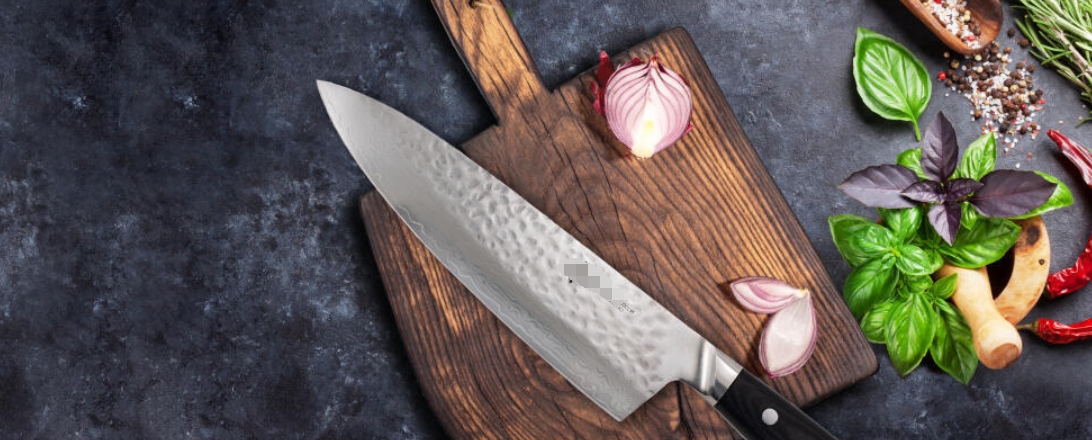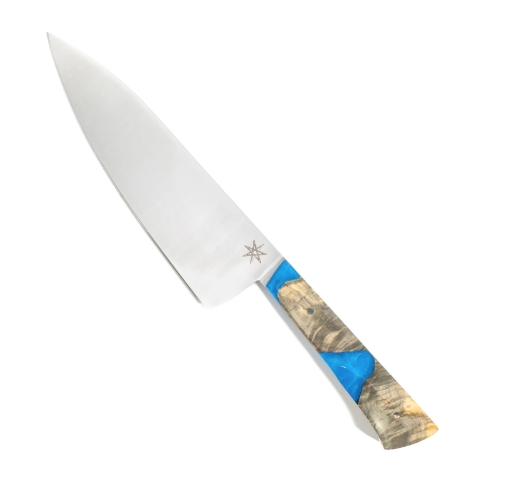

Views: 222 Author: Ella Publish Time: 2025-04-19 Origin: Site








Content Menu
>> Construction
>> Edge Retention and Sharpness
● Top Kitchen Knives for Professional Chefs (with Images & Videos)
>> 1. Mac Professional Series 8-Inch Chef's Knife (MTH-80)
>> 2. Wüsthof Classic 8-Inch Chef's Knife
>> 3. Shun Classic 8-Inch Chef's Knife
>> 4. Victorinox Fibrox Pro 8-Inch Chef's Knife
>> 5. Miyabi Birchwood Chef's Knife
>> 6. Tojiro DP Gyuto Chef's Knife
>> 7. New West KnifeWorks 9-Inch Chef's Knife
● How to Choose the Right Knife for Your Needs
● Importance of Knife Skills in Professional Kitchens
● How to Test and Compare Chef's Knives
● The Role of Knife Balance and Ergonomics
● The Evolution of Kitchen Knives: Tradition Meets Innovation
● Frequently Asked Questions (FAQ)
>> 1. What is the best all-purpose kitchen knife for professional chefs?
>> 2. How often should professional chefs sharpen their knives?
>> 3. Should I choose a Japanese or German-style chef's knife?
>> 4. What is the ideal blade length for a chef's knife?
>> 5. Are expensive knives worth the investment for professionals?
Selecting the best kitchen knives for professional chefs is both an art and a science. The right knife can dramatically improve efficiency, safety, and the overall cooking experience. In this comprehensive guide, we'll explore the top kitchen knives favored by professionals, break down what makes a knife truly exceptional, and offer expert advice on choosing, caring for, and using your knives. Throughout, you'll find illustrative images and curated video content to deepen your understanding.

In any professional kitchen, the chef's knife is the most indispensable tool. A top-quality knife is an extension of the chef's hand, enabling precision, speed, and safety. But with the vast array of brands, materials, and styles available, how do professional chefs decide which knives to trust? This guide draws on expert reviews, chef testimonials, and rigorous product testing to answer that question definitively.
Understanding the anatomy of a chef's knife is crucial for making an informed choice. Here are the key components:
- Blade: The cutting edge, typically 6–14 inches in length for chef's knives.
- Spine: The unsharpened back of the blade, providing strength.
- Edge: The sharpened part of the blade for cutting.
- Bolster: The thick junction between the blade and handle, offering balance and safety.
- Tang: The part of the blade that extends into the handle. A full tang provides superior strength and balance.
- Handle: Made from wood, plastic, or composite materials, designed for comfort and grip.
Professional chefs rely on a variety of knives, each designed for specific tasks. Here are the essentials:
| Knife Type | Typical Length | Primary Use | Example Brands |
|---|---|---|---|
| Chef's Knife | 8–10 inches | All-purpose: chopping, slicing, dicing | Mac, Wüsthof, Shun |
| Paring Knife | 3–4 inches | Peeling, trimming, detail work | Victorinox, Global |
| Utility Knife | 6–8 inches | Slicing, cutting vegetables, sandwiches | Misen, Mercer |
| Boning Knife | 5–7 inches | Separating meat from bone | Dexter-Russell, Shun |
| Cleaver | 6–8 inches | Chopping through bone, large cuts | ShiBaZi, CCK |
| Bread Knife | 8–10 inches | Slicing bread and pastry | Wüsthof, Mercer |
- High-Carbon Stainless Steel: Combines sharpness retention, corrosion resistance, and ease of maintenance. Most premium chef's knives use this alloy.
- Carbon Steel: Holds a razor-sharp edge but requires diligent care to prevent rust and discoloration. Favored by some traditionalists for its performance.
- Stainless Steel: Highly resistant to rust but may be harder to sharpen.
- Forged vs. Stamped: Forged knives (made from a single piece of steel) are generally stronger, better balanced, and more durable than stamped knives.
- Full Tang: The blade extends through the handle, providing superior balance and strength.
- Ergonomics: A comfortable, slip-resistant handle reduces fatigue and increases control.
- Material: Wood, pakkawood, and synthetic handles each offer different aesthetics and grip qualities.
- The knife should feel balanced and natural in your hand, not too heavy or too light.
- A high-quality knife should maintain a sharp edge through extended use and be easy to hone or sharpen as needed.
Below are the most recommended chef's knives, based on professional testing, chef endorsements, and industry reputation.
- Blade: High-carbon stainless steel
- Handle: Pakkawood
- Weight: 6.5 ounces
- Features: Exceptionally sharp, hybrid Western-Japanese design, excellent edge retention
- Best for: All-purpose use, professionals seeking versatility and sharpness
- Blade: German high-carbon stainless steel
- Handle: Synthetic (polyoxymethylene)
- Weight: 8.5 ounces
- Features: Heavier, robust, triple-riveted handle, excellent for tough cuts
- Best for: Chefs who prefer a weightier, Western-style knife
- Blade: VG-MAX Japanese steel
- Handle: PakkaWood
- Weight: Lightweight
- Features: Razor-sharp, thin blade, beautiful Damascus pattern, ideal for precision work
- Best for: Chefs who value sharpness, aesthetics, and finesse
- Blade: Stainless steel
- Handle: Fibrox (textured, slip-resistant)
- Weight: Moderate
- Features: Affordable, durable, widely used in commercial kitchens
- Best for: Budget-conscious professionals, prep work, butchering
- Blade: SG2 micro-carbide powder steel
- Handle: Birchwood
- Features: Ultra-sharp, beautiful craftsmanship, excellent for precision
- Best for: Chefs who want a high-end Japanese knife for delicate tasks.
- Blade: VG-10 core, stainless cladding
- Handle: Reinforced laminated material
- Features: Affordable Japanese option, sharp, great for transitioning from Western to Japanese styles
- Best for: Chefs seeking value and performance.
- Blade: CPM S35VN steel
- Handle: Custom resin or wood
- Features: Premium American craftsmanship, ergonomic, resilient
- Best for: Chefs wanting a standout, artisan knife

Selecting the ideal kitchen knife involves considering several factors:
- Cutting Style: Do you rock-chop, push-cut, or tap-chop? Choose a blade shape that complements your technique.
- Hand Size and Comfort: The handle should fit comfortably and securely in your hand.
- Weight Preference: Some chefs prefer heavy, robust knives (German style); others like lighter, agile blades (Japanese style).
- Maintenance: Carbon steel requires more care but offers sharper edges; high-carbon stainless is lower maintenance.
- Budget: High-end knives are an investment, but excellent options exist at every price point.
Proper care extends the life and performance of your knives:
- Sharpening: Use a whetstone or professional sharpening service regularly. Honing rods help maintain the edge between sharpenings.
- Cleaning: Hand-wash knives immediately after use; never put them in the dishwasher.
- Storage: Use a knife block, magnetic strip, or blade guards to prevent damage.
- Handling: Always use the correct grip (pinch grip for chef's knives) for control and safety.
A great knife is only as effective as the chef wielding it. Knife skills form the foundation of professional cooking, affecting everything from prep speed to the final presentation of a dish. Mastery of techniques like julienne, chiffonade, brunoise, and precise filleting can elevate a chef's work and create visually stunning plates.
Professional kitchens often require chefs to process large quantities of ingredients quickly and uniformly. A sharp, well-balanced knife reduces fatigue, increases accuracy, and helps prevent injuries. Many culinary schools devote significant time to knife skills, emphasizing the importance of practice and proper technique.
When investing in a new chef's knife, hands-on testing is invaluable. Most culinary stores allow chefs to handle knives before purchasing. Here are some practical tests professionals use:
- Paper Test: A sharp knife should slice cleanly through a sheet of paper with minimal effort.
- Tomato Test: The blade should glide through a ripe tomato without crushing it.
- Onion Test: Dicing an onion reveals how the knife handles both precision and repetitive motion.
- Balance Test: Hold the knife at the bolster—does it feel evenly balanced or tip-heavy?
Chefs often compare several knives side by side, considering comfort, sharpness, and control. Ultimately, the best knife is the one that feels like a natural extension of your hand.
Balance and ergonomics are critical for professional chefs who spend hours each day prepping ingredients. A well-balanced knife allows for more efficient, fatigue-free cutting. The balance point—typically where the blade meets the handle—should feel neutral, enabling both delicate and forceful cuts.
Ergonomics refers to how the knife fits your grip and hand size. Handles should be contoured and non-slip, reducing the risk of blisters or strain. Some brands offer different handle shapes or materials to cater to individual preferences. Testing knives in person is the best way to determine the right fit for you.
The world of kitchen knives is a fascinating blend of tradition and innovation. Japanese knife-making, for example, draws on centuries-old techniques originally developed for samurai swords. Brands like Shun and Miyabi continue this legacy, combining traditional forging with modern steel alloys and ergonomic designs.
Meanwhile, Western brands such as Wüsthof and Victorinox have refined the classic German chef's knife, focusing on durability, versatility, and user comfort. Recent innovations include powder metallurgy steels, laser-cut blades, and antimicrobial handle materials.
Today's professional chefs benefit from this global exchange of ideas, with access to knives that are sharper, more durable, and more beautiful than ever before.
The best kitchen knives for professional chefs combine superior materials, expert craftsmanship, and thoughtful design. Whether you prefer the razor-sharp precision of a Japanese blade or the sturdy reliability of a German classic, the right knife will elevate your cooking and last for years with proper care. Invest in a knife that feels like an extension of your hand, and you'll find that prep work becomes faster, safer, and more enjoyable.
Remember, even the finest knife requires skill, maintenance, and respect. Take the time to develop your knife skills, care for your blades, and select tools that inspire confidence. The result will be not only better food but also a more rewarding culinary journey.

The Mac Professional Series 8-Inch Chef's Knife (MTH-80) is widely regarded as the best all-purpose knife, blending Western and Japanese design for versatility, sharpness, and durability.
Most professionals sharpen their knives every few months, depending on use, and hone them before each use to maintain the edge.
Japanese knives are lighter, sharper, and excel at precision work, while German knives are heavier, more robust, and better for tough tasks. Many chefs use both styles for different purposes.
An 8-inch blade is the most popular and versatile size for most chefs, balancing control and cutting power.
High-quality knives offer superior performance, durability, and comfort, making them a worthwhile investment for professionals who rely on their tools daily. However, excellent value options exist for those on a budget.
[1] https://www.nytimes.com/wirecutter/reviews/the-best-chefs-knife-for-most-cooks/
[2] https://www.foodnetwork.com/how-to/packages/shopping/product-reviews/best-chefs-knife
[3] https://sharpedgeshop.com/blogs/knives-101/how-to-choose-a-kitchen-knife
[4] https://www.youtube.com/watch?v=GKyCg_GUGd0
[5] https://www.reddit.com/r/chefknives/comments/lutn7c/what_knives_do_professional_chefs_in_general_use/
[6] https://theintrepidgourmet.com/2023/04/03/how-to-choose-a-chef-knife/
[7] https://www.performancefoodservice.com/get-inspired/a-guide-to-kitchen-knives
[8] https://www.forbes.com/sites/forbes-personal-shopper/article/best-chefs-knife/
[9] https://artisanrevere.com/blogs/education/knife-faq-and-problem-solving
[10] https://knife-depot.com/pages/the-complete-guide-to-buying-kitchen-knives
[11] https://www.epicurious.com/expert-advice/best-chefs-knife-article
[12] https://www.seriouseats.com/the-best-chefs-knives
[13] https://www.reddit.com/r/Cooking/comments/1geuqvi/what_are_some_good_knife_brands_for_a_moderate/
[14] https://www.foodandwine.com/lifestyle/kitchen/best-chefs-knife
[15] https://www.wusthof.com/collections/all-purpose-knives/chefs-knives
[16] https://www.macknife.com/collections/chefs-knives
[17] https://eatingtools.com/collections/chef-knives
[18] https://www.epicurious.com/expert-advice/best-chefs-knife-article
[19] https://forum.spyderco.com/viewtopic.php?t=96561
[20] https://www.tigerchef.com/complete-guide-to-kitchen-knives.html
[21] https://www.youtube.com/watch?v=7VLItPQICZQ
[22] https://www.williams-sonoma.com/shop/cutlery/cutlery-chef-knives/
[23] https://seidoknives.com/collections/chef-knife-sets
[24] https://www.kitchenknifeforums.com/threads/help-picking-a-first-chefs-knife-for-husband.50719/
[25] https://www.epicedge.com/shopcontent.asp?type=FAQ_ee
[26] https://elementknife.com/pages/common-questions-about-kitchen-knives
[27] https://sharpedgeshop.com/blogs/knives-101/guide-maintenance-of-kitchen-knives
[28] https://www.kitchenknifeguru.com/knives/best-chef-knives-six-recommendations/
[29] https://www.mercerculinary.com/preview/faqs/
[30] https://www.coldsteel.com/faqs/
[31] https://www.cordonbleu.edu/london/chef-knife/en
[32] https://theveroknives.com/blogs/faq-guides/the-ultimate-kitchen-knife-guide-expert-faqs-maintenance-tips-and-buying-advice
[33] https://www.bladeforums.com/threads/question-for-the-kitchen-knife-folks-and-chefs.1298526/
[34] https://honestknives.com/knife-faq-help-center/
[35] https://www.reddit.com/r/chefknives/comments/175owpj/what_recomondations_for_the_first_more_serious/
[36] https://nymag.com/strategist/article/best-kitchen-knife-sets.html
[37] https://www.youtube.com/watch?v=QgVyN6Lpiuc